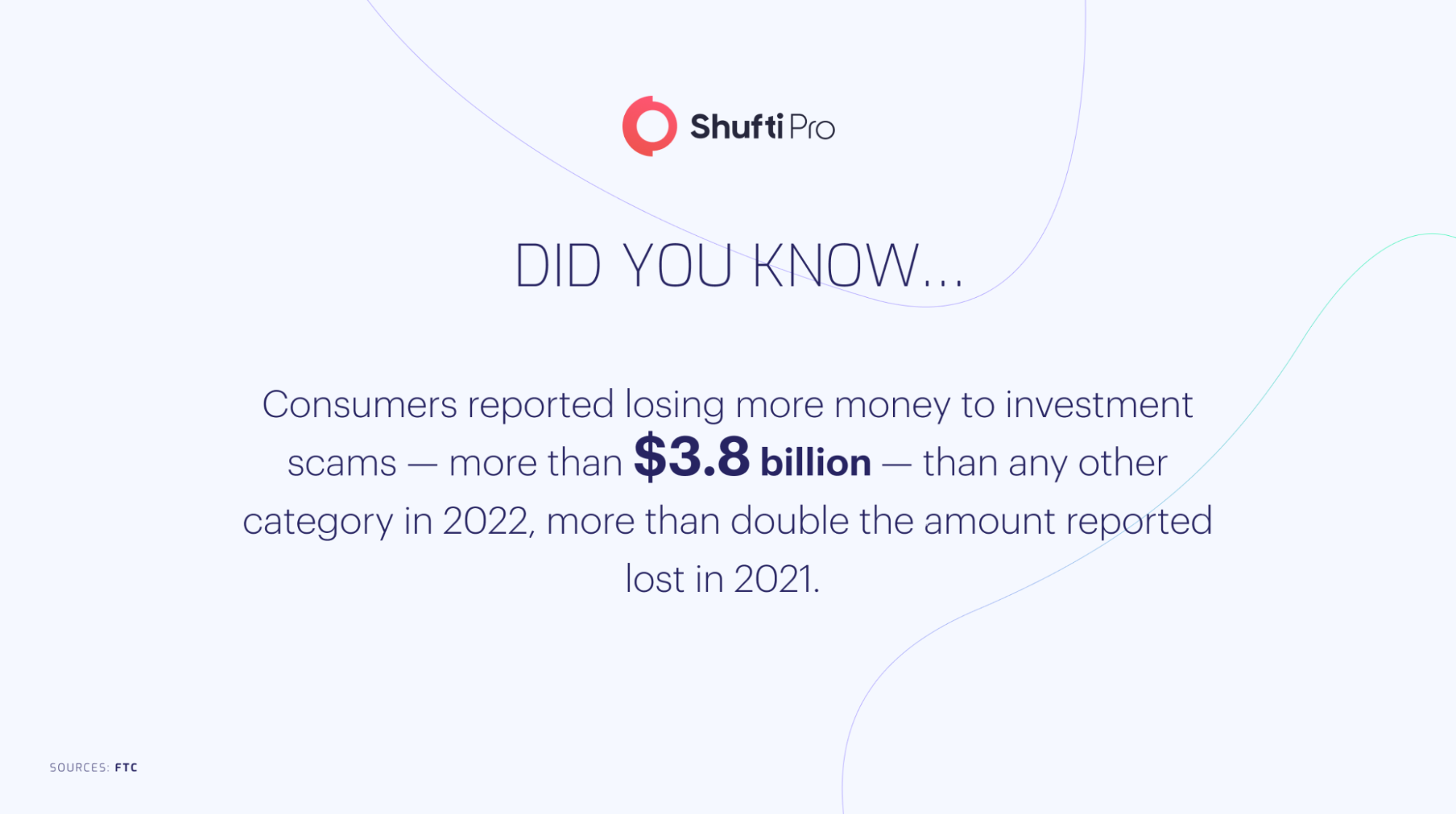Investor Onboarding | Navigating the Challenges of Digitization

- 01 What is Investor Onboarding?
- 02 Why is a Legitimate Investor Onboarding Process Important?
- 03 What Steps Are Involved with Onboarding Investors?
- 04 Back-End Complexities in the Digital Investment Sector
- 05 Digital Investor Onboarding: The Ultimate Solution
- 06 Onboarding Legitimate Investors with Shufti
Private market companies are setting their sights on retail investors and exploring technology and innovative funding structures to overcome the sector’s barriers. Such retail investors are turning to private markets for diversified risk, enhanced returns, and lower volatility. With the high stakes, the private equity assets market is anticipated to grow by 10.2% yearly, while venture capital investments are positioned to surpass $659 billion by the end of 2027 compared to $531 billion as of 2022.
However, today’s investors expect a digital onboarding experience from wealth managers that parallel standards seen across all other major online marketplaces. To meet this growing demand, wealth managers are going digital while offering several financial services, such as managing investor wealth, finding opportunities to create more wealth, and revisiting investment plans after periodic intervals. Forrester, the research agency, investigated wealth managers and found some interesting outcomes from the shift to digital. For instance, using automated investor verification solutions reduces initial onboarding time to a few minutes, resulting in more than 90% enhancement and increased customer conversion rates. Despite the fact the investment sector is transforming, it is exposed to increased risk of crimes, leading to significant financial losses.
What is Investor Onboarding?
Investor onboarding is introducing new investors to a financial or investment platform while screening them against financial crime databases by undergoing KYI checks to ensure that their initial investments are coming from legitimate sources. The traditional procedure usually takes months to ensure a seamless execution. However, investment firms can use automated Know Your Investor (KYI) checks to carry out the same process within seconds.
The first step of the KYI verification process is to identify the true identities of investors, followed by anti-money laundering screening and rigid due diligence checks. AML is one of the key steps in investor onboarding as it helps businesses screen their potential investors against a global financial crime database, ensuring that they are not linked with any crime. Once investors undergo the AML screening phase, they can make transactions.
Why is a Legitimate Investor Onboarding Process Important?
As mentioned, investor onboarding is a critical component of a fundraising process, so why exactly is this so important to investment firms? Firstly, meeting know your investor compliance is a regulatory obligation, and verifying identities helps firms meet this requirement while adhering to other regulations, such as Know Your Customer (KYC) and Anti-Money Laundering (AML) standards. An effective onboarding procedure ensures that KYI, KYC, and AML checks are practiced systematically, reducing the risk of onboarding fraudsters and effectively deterring financial crime.
In addition to meeting compliance requirements, the investor onboarding process is also imperative in creating a positive impression among the investor community, leading to long-lasting relationships. This can only be achieved by integrating state-of-the-art KYI solutions, while a slow, tedious investor onboarding procedure can lead to increased drop-offs and delays in capital deployment.
Ultimately, a frictionless onboarding journey frees up the capacity for investment firms to focus on value-adding tasks, for instance, finding new investors and managing investment portfolios.

What Steps Are Involved with Onboarding Investors?
Across all jurisdictions, particularly across Europe and the US, investment firms must practice certain checks to ensure compliance onboarding. These steps include:
- Information Collection: Gather investors’ personally identifiable information, government-issued identity documents, and investor profiles required to complete the onboarding process.
- Document Authentication: automated checks create the templates and match them against ID documents placed in the database.
- AML Screening: Undergo background screening against financial crime databases to verify that the potential investor has a clean track record.
- Results: An investor is onboarded and authorized to make investments upon successful verification.
While the above steps look simple, if done manually, they are complex processes involving an array of emails, form filling, and ongoing communication with each potential investor. This way of onboarding is not adequate for anyone involved, including investors, customers, and the firm. Practicing manual onboarding processes can damage investment firms’ reputations, leading to inconvenience and decreased conversion rates. Additionally, it could expose a firm to various risks, including GDPR compliance breaches, especially around gathering and managing investors’ personally identifiable information. Some investors may also find the onboarding process hectic, leading to frustration and backing out of their investments while investing their funds elsewhere. For these reasons, the investor onboarding process should be simple, investor-centric, and hassle-free for every entity involved.
Back-End Complexities in the Digital Investment Sector
By harnessing the power of automation, enhancements being made within customer onboarding processes are notable. The unnecessary complexity and blocks around compliance, verification, onboarding, and payments adversely impact both investors and the firm.
Compliance Roadblocks
Any digital service other than opening a bank account can lead to a complex compliance structure and due diligence extensiveness. However, the compliance is designed to secure investors’ integrity. Many investment firms have failed to connect the disparate set of advanced technologies and services to make the investor onboarding journey frictionless. From investors’ identity verification to due diligence checks to AML screening, interjection of human resources and manual processes can become the reason for fluctuating investor onboardings, leading to lousy customer journeys.
Order Execution Bottlenecks
While the transactions of buying simply equity are fast, the tantalizing dream of T+1 settlements still requires the swift execution of transactions. However, the US has a regulatory agenda for this issue, while India is pioneering the way to enhance the process. Still, surely investors who make same-day transactions for other payments will find it difficult to understand why this is not the same for securities; after all, it’s just a data transfer. In addition to delays, investment fund order execution is notoriously inconsistent. End-of-month clauses are uncommon and take days and months before money is invested. Those seeking to get benefits of timing and market corrections end up frustrated. Near to an investor, validation is not a necessary prerequisite for a purchase.
Transfer Delays
While it’s challenging for many to completely understand why automated processes have not transformed the whole wealth management sector, some significant hurdles are more complex and fundamental than others – including transferring funds, switching between multiple wealth managers, and meeting regulatory obligations all while restricting to manual expert reviews and checks. Perhaps the most acute problem among these is the transfer of assets or wealth. The transfer between highly regulated and privately managed or self-directed schemes represents one of the most hectic and time-consuming processes investors face. It usually takes many months to process the transfer of wealth – by which time the market situation has most likely changed. Dealing with this specific problem has become an industry-wide challenge.
Manual Onboarding Process
Conventional paper-based investor onboarding processes require multiple human resources and outside counsel to handle document processing, including limited partner or non-disclosure agreements, side letters, and tax documents, while ensuring Anti-Money Laundering and Know Your Customer monitoring checks. However, managing this process manually requires spreadsheets, checklists, emails, and disparate platforms. In addition to this, determining the investors’ status also slows down the onboarding speed. This back-and-forth array of processes, including paperwork, signatures, and follow-ups, can take days and even months to verify the identity of an investor. However, harnessing the power of automation can streamline onboarding while eliminating the risk of inefficiency, frustrations, delays, and investor drop-offs.
Digital Investor Onboarding: The Ultimate Solution
Finally, in today’s digital-first world, digitizing the entire journey using automation technologies is the best way to simplify the investor onboarding process and communicate effectively.
The question arises: how? An automated investor onboarding automatically reduces the potential of human error, removes friction, increases transparency, automates document processing, eliminates human interventions, and reduces onboarding time – all while enhancing the customer journey.
Here are some prominent examples of leveraging technology to enhance investor onboarding:
- Optical character recognition (OCR) scanner to fast-track document verification using automated data extraction.
- E-signature to automate approvals
- Face biometric authentication for liveness detection and contactless onboarding.
- Customer relationship management solutions to track investors’ interactions, payments, and other activities.
- Integration with third-party identity verification services can save cost and onboarding time.
- Automated document verification solutions can streamline onboarding processes.
- NFC-based solutions can make payments more robust and secure.
However, investment and wealth management firms may have ample time and resources to automate each investor onboarding procedure component. Still, automation technologies can benefit by digitizing repetitive and redundant tasks while streamlining more complex aspects of the process.
Luckily, your business doesn’t need to worry, there is a state-of-the-art investor onboarding solution that can streamline your onboarding journey – Shufti!
Onboarding Legitimate Investors with Shufti
Shufti, a pioneer in offering identity verification services, provides investment firms with robust and technology-backed know your investor verification solutions that aid companies in determining investors’ identities while authenticating their status and documents in real-time. Our solution supports 10,000+ ID document types in more than 150+ languages with coverage across 240+ countries & territories, making it simple for businesses to authenticate their investors without delays.
With Shufti, your business can:
- Ensure only legitimate investors are onboarded, mitigating potential risks.
- Safeguard your business and mitigate risk with our experienced Money Laundering Reporting Officers.
- Reduces internal compliance costs by up to 60%.
- Comply with regulations and safeguard your business reputation.











